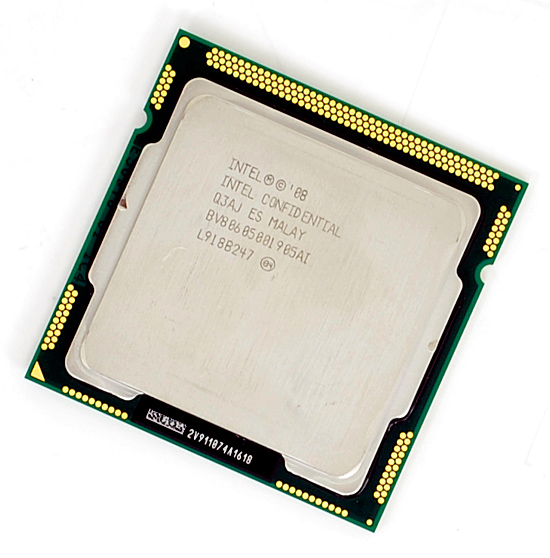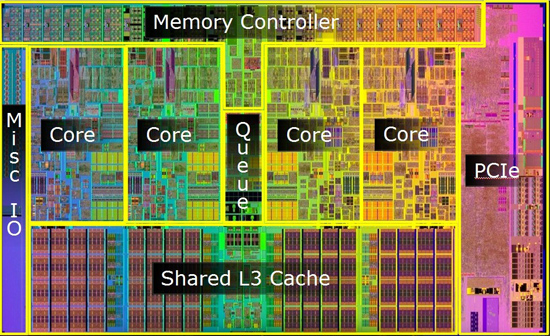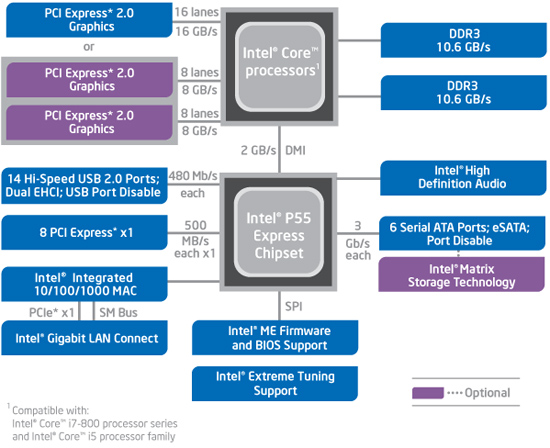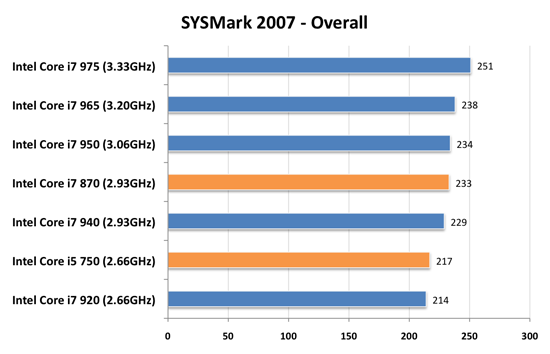Intel's Core i7 870 & i5 750, Lynnfield: Harder, Better, Faster Stronger
by Anand Lal Shimpi on September 8, 2009 12:00 AM EST- Posted in
- CPUs
Intel is on the verge of transitioning to 32nm. We'll see the first parts this year. What do you do with your 45nm fabs when you start moving volume away from them? Make really cheap quad-core Nehalems of course:

I'm talking $196. I'm talking faster than AMD's entire lineup. I'm talking about arguably the best processor of 2009. I'm talking about Lynnfield, and here's its backside:

Mmm
I spent much of the past year harping on AMD selling Nehalem-sized Phenom IIs for less than Intel sold Nehalems. With Lynnfield, Intel actually made Nehalem even bigger all while driving prices down. Like I said, what do you do when you're still making boatloads of money in a recession and are about to start emptying your 45nm fabs?
I should clear things up before we progress much further. Lynnfield is the codename for mainstream 45nm quad-core Nehalem, while Bloomfield refers to the first Nehalem launched at the end of 2008:
| Processor | Manufacturing Process | Die Size | Transistor Count | Socket |
| Bloomfield | 45nm | 263 mm2 | 731M | LGA-1366 |
| Lynnfield | 45nm | 296 mm2 | 774M | LGA-1156 |
Despite being cheaper, Lynnfield is larger than Bloomfield. The larger die is due to one major addition: an on-die PCIe controller.

Bloomfield, The First Nehalem, circa 2008

Lynnfield, Nehalem for All, circa 2009
The pink block to the right of the die is the PCIe controller, that's 16 PCIe 2.0 lanes coming right off the chip. Say hello to ultra low latency GPU communication. You'd think that Intel was about to enter the graphics market or something with a design like this.
Sacrifices were made to reduce CPU, socket and board complexity. Gone are the two QPI links that each provided 25.6GB/s of bandwidth to other CPUs or chips on the motherboard. We also lose one of the three 64-bit DDR3 memory channels, Lynnfield only has two like a normal processor (silly overachieving Bloomfield).

Intel's Bloomfield Platform (X58 + LGA-1366)
The sum is that Lynnfield is exclusively single-socket; there will be no LGA-1156 Skulltrail. While the dual-channel memory controller isn't really a limitation for quad-core parts, six and eight core designs may be better suited for LGA-1366.

Intel's Lynnfield Platform (P55 + LGA-1156)
The loss of QPI means that Lynnfield doesn't have a super fast connection to the rest of the system, but with an on-die PCIe controller it doesn't matter: the GPU is fed right off the CPU.
The Lineup
We get three Lynnfield CPUs today: the Core i7 870, Core i7 860 and the Core i5 750. Intel's branding folks told us that the naming would make sense one we saw the rest of the "Core" parts introduced; yeah that was pretty much a lie. At least there aren't any overlapping part numbers (e.g. Core i5 860 and Core i7 860).
The i7 in this case denotes four cores + Hyper Threading, the i5 means four cores but no Hyper Threading. The rules get more complicated as you bring notebooks into the fray but let's momentarily bask in marginal simplicity.
| Processor | Clock Speed | Cores / Threads | Maximum Single Core Turbo Frequency | TDP | Price |
| Intel Core i7-975 Extreme | 3.33GHz | 4 / 8 | 3.60GHz | 130W | $999 |
| Intel Core i7 965 Extreme | 3.20GHz | 4 / 8 | 3.46GHz | 130W | $999 |
| Intel Core i7 940 | 2.93GHz | 4 / 8 | 3.20GHz | 130W | $562 |
| Intel Core i7 920 | 2.66GHz | 4 / 8 | 2.93GHz | 130W | $284 |
| Intel Core i7 870 | 2.93GHz | 4 / 8 | 3.60GHz | 95W | $562 |
| Intel Core i7 860 | 2.80GHz | 4 / 8 | 3.46GHz | 95W | $284 |
| Intel Core i5 750 | 2.66GHz | 4 / 4 | 3.20GHz | 95W | $196 |
Keeping Hyper Threading off of the Core i5 is purely done to limit performance. There aren't any yield reasons why HT couldn't be enabled.
Intel was very careful with both pricing and performance of its Lynnfield processors. I'm going to go ahead and say it right now, there's no need for any LGA-1366 processors slower than a Core i7 965:

This is only one benchmark, but it's representative of what you're about to see. The Core i7 870 (LGA-1156) is as fast, if not faster, than every single LGA-1366 processor except for the ones that cost $999. Its pricing is competitive as well:

For $196 you're getting a processor that's faster than the Core i7 920. I'm not taking into account motherboard prices either, which are anywhere from $50 - $100 cheaper for LGA-1156 boards. I don't believe LGA-1366 is dead, but there's absolutely no reason to buy anything slower than a 965 if you're going that route.










343 Comments
View All Comments
Jamahl - Tuesday, September 8, 2009 - link
Digusting! How much money did intel bung you for this disgrace?strikeback03 - Tuesday, September 8, 2009 - link
How is that disgusting? It is the stock configuration of the processor. They are not doing all this testing as an e-pissing contest of who has better performance per clock, it is a comparison of retail products in real-world applications. If (and according to the review, when) AMD has something similar, I'd imagine they will test with that turned on too.Jamahl - Tuesday, September 8, 2009 - link
Why not benchmark the Phenom 2 with fusion for gaming anand???Gary Key - Tuesday, September 8, 2009 - link
"Why not benchmark the Phenom 2 with fusion for gaming anand??? "Have you actually tried using Fusion with Windows 7 x64? It is a total mess. I will be happy to show some results with it, most will say DNF, but that might not make you happy. ;) That said, AMD is working on it, especially trying to get it to play nice with AOD.
In the meantime, here is the current list of items to watch out for - http://game.amd.com/us-en/drivers_fusion.aspx?p=3&...">http://game.amd.com/us-en/drivers_fusion.aspx?p=3&... .
Jamahl - Tuesday, September 8, 2009 - link
What? It's AMD's fault that an unreleased 64-bit os is causing issues with their software?How many people are using Window 7 64 bit who visit this website?
Gary Key - Tuesday, September 8, 2009 - link
It is just as bad in 64-bit Vista. I imagine a fair amount of people that visit the site are using the RTM version of Win7.Jamahl - Tuesday, September 8, 2009 - link
were you benchmarking a processor at 2.66 gigahertz or a processor at 3.2 gigahertz?Gary Key - Tuesday, September 8, 2009 - link
Do you and SnakeOil live in the same house or is the IP address just that similar? LOL.. The processors were benched as they come out of the box. For Lynnfield that means turbo was on as we stated in the article and here in the comments. For Bloomfield, that also means turbo was on, just as it comes out of the retail box.If you check all the other reviews on the web at the main sites, everyone tested with turbo on in the primary benchmarks. So I guess you can say there is a huge conspiracy between us to actually utilize the processors as Intel intended for the users.
Apparently, we all failed at covering it up, so congratulations on discovering the Freeturbomasons. A now not so secret fraternal organization bent on world domination through the use of turbo frequencies inside processors carrying the blue "i" logo.
For the AMD Phenom II x4 series, they were benched with all cores enabled just as they come out of the box, even though you can disable each core in the BIOS just like you can disable turbo on the i7/i5. I guess to make things fair, we should disable the cores on the 965 BE as having that "feature" turned on is cheating.
Anyway, thanks for making my day, I needed some much deserved laughter. :)
Chlorus - Tuesday, September 8, 2009 - link
Seeing as how Fusion isn't even out yet, that would be hard to do...go troll somewhere else. What is with the idiots coming out of the woodwork on this post? You've got the standard fanboys, as well as insecure LGA-1366 owners who feel the need to defend their purchase, and insecure purchasers of 1156 products who are afraid their choice might be bested in a benchmark somewhere.Roland00 - Tuesday, September 8, 2009 - link
Would you please rerun page 9 with an overclocked 975 and the 870. I am wondering how much the difference will grow when the gpus are fed more information due to the faster cpus. Something like 3.8 to 4.0 ghz on both cpus with turbo off (a good overclock yet not in the unreasonable area)If you are investing 400+ dollars in gpus, and you are building it yourself you are probably going to overclock.